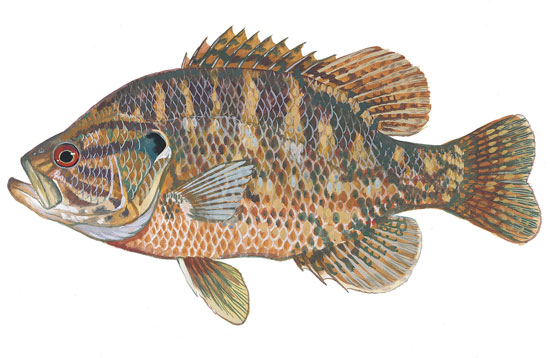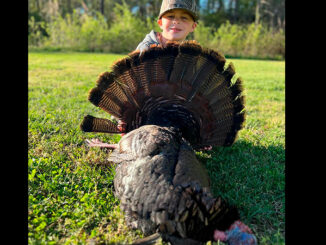
Big-mouthed panfish are common in swamps, small rivers
The warmouth is one of the more interesting and often misunderstood (and just as often, misidentified) species of the sunfish family.
This fish (Lepomis gulosus) is native to both Carolinas, and while many people believe it is a cross between a crappie and a bass, a crappie and a bream, or a bream and a bass, it’s actually not the product of any crossbreeding. The warmouth is its own species of sunfish. It is closely related to bluegill and redbreast.
The very name “warmouth” has some mystery behind it. Some believe the name comes from the markings that extend from the mouth to the eyes, which resemble the facial war paint used by Native Americans. Others think the sheer size of the mouth, which is similar to the mouth of a bass, gives the fish its name. “Mouth so big you could have a war in it!” Still others believe it’s the mispronunciation of “more mouth,” which this fish has over almost all of its sunfish relatives.
Proportionately longer than most other sunfish, warmouths typically have red eyes, a mottled or splotchy body of olive brown with a purple sheen, and prominent lines that run down the body, as well as away from the mouth. Their dark earflaps are short, stiff, and sometimes have a small reddish spot. And as mentioned above, their mouths extend to about the midway point of their pupil. This allows the lips to flare like that of a bass or crappie.
When spawning, male warmouths often display a bright red or orange spot at the base of the dorsal fin.
Warmouths are found in various types of water
These fish are usually found in slower moving water, like swamps, small streams, or brown and black water tributaries of rivers. But it’s not unheard of to find them in ponds and some lakes. They have a high tolerance for dirty, muddy water. Warmouth are somewhat more dispersed throughout South Carolina than North Carolina, as they are very scattered and found in much smaller numbers on the western side of the Tarheel State.
The Black, Catawba and Pee Dee river basins, along with the Waccamaw, Lumber, Cape Fear, Chowan, and White Oak river basins all contain hearty numbers of warmouth, which do most of their feeding on smaller fish, insects, crayfish, and shrimp.
Like most sunfish, the males build nests mainly by fanning out areas with their tails. Big groups of nests are often built together, sometimes among dozens of other warmouth nests. In tight quarters, warmouth will also construct nests among the nests of other sunfish species. They spawn throughout late spring and summer as long as water temperatures are warmer than 70 degrees.
Females lay between 2000 and 20,000 eggs, and divide them up between multiple nests. Warmouth guard their eggs, and stay with hatchlings for a short time period.
These fish are a blast to catch, especially on ultralight gear
Anglers can catch them with live worms, crickets, small crayfish, minnows, and small spinning lures like Mepps Aglias, Beetlespins, and Roostertails. Ultralight crankbaits such as the Rebel Wee Craw and Crickhopper lures are also good options. Fishing tight to cover like stumps, logs, vegetation, and river banks is a good bet for anglers. Incoming waterways like smaller creeks or even rainwater runoff are always promising spots too.
Using ultralight rods and reels will ensure anglers a fun and good battle, and will make these spunky fighters feel much bigger than they are. They are often caught amongst bluegill, redbreast, shellcracker, and other sunfish.
Like most of their sunfish relatives, warmouth are considered tasty table fare.
These fish are often misidentified as bluegill, redbreast, smallmouth bass, crappie, rock bass, and green sunfish.
Warmouth are known by several other names across the Carolinas. These include more-mouth, mo-mouth, morgan, molly, stump knocker, goggle-eye, red eye, red-eyed perch, and red-eyed bream.
The average warmouth in the Carolinas ranges from 6 to 8 inches in length. They have a life expectancy in the wild of about 8 years.
The North Carolina state record warmouth is 1-pound, 13-ounces, and has stood since May 7, 1976. The fish was caught by Emma Sears in McLeod’s Pond in Richmond County.
The South Carolina state record is 2-pounds, 2.5-ounces. It was caught in a Clarendon County swamp by W. Singletary in 1973.
The world record warmouth was caught from the Yellow River in Holt, Florida in 1985, and weighed 2-pounds, 7-ounces.




